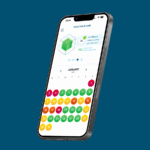Medication adherence as the keystone in COPD management success
- Chronic Obstructive Pulmonary disease (COPD) is a chronic respiratory illness that can be treated with various pharmacological options usually delivered via inhaled therapies1.
- Adherence to COPD medication is as low as 20-30%, resulting in disease exacerbation, severity of symptoms, increased risk of hospitalization, and decreased health-related quality of life1,2.
- Interventions tailored to individual barriers, shared decision-making, and adopting multi-component approaches were found to be successful in enhancing adherence to COPD treatment1,3.
Chronic obstructive pulmonary disease (COPD) is a common chronic respiratory illness that affected 480 million people or ~10.6% of the adult population globally in 20204. As per the global burden of diseases (GBD, 2013) it is the fifth most common cause of years lost due to disability-adjusted life expectancy. By 2012 it became the third leading cause of death by claiming as many as 3 million lives across the globe; 90% of which occur in low-to-middle-income countries. The global burden of COPD, albeit avoidable, is projected to increase to 600 million by 2050 due to enhanced exposure to the risk factors and the global aging population1,4.
Understanding COPD: Symptoms and Causes
COPD is a heterogeneous progressive lung disease characterized by shortness of breath and cough with/without sputum due to airway obstruction or alveoli abnormalities (Figure 1). The disease results from a complex interaction between an individual’s genetics and exposure to the risk factors, gene-environment interaction over lifetime1.
- The environmental factors are inhalation of toxic particles or gases through1,5,
- Tobacco smoking
- Outdoor air pollution
- Occupational exposure
- Exposure to biomass
- Host factors include reduced lung function due to,
- Abnormal lung development and accelerated lung aging
- Respiratory infections and asthma
- α-1 antitrypsin deficiency due to SERPINA1 gene mutation1

Figure 1: Overview of chronic obstructive pulmonary disease: causes and symptoms1.
(The figure is for illustration purposes only and is based on information from GOLD 20231)
COPD prevalence is higher in smokers/ex-smokers, age ≥40, and men as compared to women. The disease remains underdiagnosed as it often exists with other co-morbidities presenting an important public health issue that is both preventable and treatable 1,6.
Managing COPD: Pharmacological therapies
Pharmacological therapies for COPD aim to reduce the symptoms, severity, and frequency of exacerbations, and improve health status. The major classes of drugs used for treating COPD are1:
- Bronchodilators – short-acting (SABA) and long-acting Beta2-agonists (LABA)
- Antimuscarinic drugs – short-acting (SAMA) and long-acting antimuscarinic (LAMA)
- Methylxanthines
- Anti-inflammatory agents – inhaled corticosteroids (ICS), oral glucocorticoids (OG)
- Mucoregulators and antioxidant agents
Inhaled bronchodilator therapy alone or in combination is central to COPD management and can be combined with inhaled corticosteroids during exacerbations. In addition to these pharmacotherapies, non-pharmacological approaches used for COPD management are smoking cessation, pulmonary rehabilitation, long-term oxygen therapy, non-invasive positive pressure ventilation, and lung volume reduction surgery1.
Adherence to COPD treatment: Why is it important?
As mentioned above, pharmacological treatments of COPD slow disease progression and may reduce severity as well as mortality1 in patients with frequent/severe exacerbations5. Non-adherence to these therapies is therefore associated with adverse consequences such as,
- poor symptom control,
- increase in exacerbations resulting in higher hospitalization rates,
- poor quality of life,
- increased costs and healthcare burden,
- higher risk of mortality1,5.
Real-world data from a Swiss population showed medication adherence to COPD treatment halved the risk of hospitalization due to exacerbations7. Similarly, a study on the Korean population reported lower rates of ICU usage (Odds ratio 0.74, 95% confidence interval 0.60–0.91) and 11.7% reduced COPD-related costs in the adherence population as compared to the non-adherent ones8. As per estimates, a 5% increase in adherence rates lowers emergency department visits and hospitalization rates by 1.8% and 2.6%, respectively2.
Prevalence of non-adherence to COPD treatment: Data from real-world
Non-adherence to the pharmacological therapy for COPD is frequently reported to be >50%. The self-reported adherence rates range from 28-74%, in high-income countries and 46-93% in low-middle-income countries1. However, it should be noted that patients generally tend to overestimate medication adherence while self-reporting. More recent estimates using electronic inhaler devices report a rate of adherence as low as 20-30% with only 6% of patients showing optimal adherence (≥80%)2.
Table 1: The rate of medication adherence (%) to different inhalation therapies in COPD
LABA – Long-acting Beta2-agonists; LAMA – long-acting antimuscarinic; ICS – inhaled corticosteroids (Data for the table is based on information from Lopez et al., 20199)
Patients escalated to triple therapy due to inadequately controlled symptoms are even less adherent and persistent to treatment10. This can be somewhat remedied by using Single-Inhaler Triple Therapy (SITT), which is reported to enhance adherence rates by 2-fold as compared to Multiple-Inhaler Triple Therapy (46.5% vs. 22.3%; P<0.001)10.
Medication adherence in COPD: Barriers to adherence
Medication adherence is a complex human behavior governed by various factors categorized as person-related, treatment-related, therapy-related, healthcare provider-related, and social/environmental. Some of the key barriers contributing to nonadherence to COPD medications are1,2:
- Patient-related: Co-morbidities, smoking status, self-beliefs, education level
- Health system-related: Trust in therapies, medication availability, poor and insufficient patient-HCP communication
- Therapy-related: Complexity in regimen, polypharmacy, adverse effects, using inhaled therapies
- Socioeconomic: Income and employment status, immigrants, living alone1,2
Most of these barriers are common for medication non-adherence in other chronic conditions except the use of inhaled therapies6. Overall, inhaled therapies are a boon for respiratory illnesses but have come to pose a major challenge in terms of incorrect device usage resulting in significant unintentional non-adherence1.
Inhaled delivery: When the solution becomes the problem!
Inhaled drug delivery is the core of pharmacological treatment in COPD. This allows for a targeted and faster drug action with minimal doses preventing the otherwise systemic adverse effects due to oral delivery11. However, taking a pill is a far simpler task when compared to operating inhaler devices. Factors like disease severity, comorbidities, cognitive function, manual dexterity, and coordination skills are limitations for using these devices. Inhaler prescriptions require initial training and follow-up assessments of the inhaling technique to ensure correct usage1,11. Therefore, correctly using inhaler devices can pose a major barrier to treatment effectiveness and adherence in COPD1,5:
- Correct inhalation technique is crucial.
Inhaled volume, inspiratory flow, and flow acceleration are important determinants of correct inhalation of the medication and its deposition in the lower respiratory tract. - Inspiratory maneuvers differ with different devices. Multiple types of inhaler devices exist, and they differ in their inhalation technique. some requiring slow and deep inhalation, while others requiring forceful inhalation.
- Inhaler devices differ in their size and portability causing inconvenience to users.
- Require multiple steps to prepare and force for loading and actuating them.
- May need period or regular cleaning as well as maintenance.
Incorrect usage of inhaler devices in COPD patients ranges from 12% to 44% resulting in enhanced risk of hospitalization and poor disease control11. Comorbidities like arthritis, muscle weakness, cardiovascular diseases, extreme obesity, and neurodegenerative diseases can also impede the correct usage of these devices5. A study in recently discharged elderly COPD patients found the mean inhaler adherence (assessing the time of dosage, frequency, and accurate technique) to be as low as 22.6%11. Device-specific considerations for inhalation technique are described in Table 2.
Table 2: Description of inhalation device characteristics and specific inhalation technique required.
(Table adapted from Hanania et al., 201811)
In general, considerations for device type and a patient’s ability to use the device correctly are overlooked. As per one report, only 37% of HCPs considered device type while prescribing COPD treatment, and only 45% assessed for the inhalation technique in new patients. Furthermore, 64% of patients were reported to be unconcerned about getting the inhalation technique right irrespective of COPD severity11. Therefore, the selection of inhaler devices and training for correct usage, discussed in the next sections, is critical for medication adherence.
Interventions and strategies to improve medication adherence in COPD
Several interventions to improve medication adherence in COPD have been employed, a few of these are discussed in detail below:
- Educational interventions: Educational interventions are key to raising awareness about disease, medication’s importance, and the consequences of non-adherence. These include discussion with healthcare professionals, access to written information/pamphlets/digital information, and pictorial or audiovisual aids3. A systematic review of educational interventions reported moderate improvements in COPD knowledge and physical activity, but not in quality of life or hospitalization rates12.
- Behavioral/psychological interventions: These include cognitive behavioral therapy, counseling, and motivational interviewing to help patients change non-adherent behavior3. Motivational interviewing as compared to control improved mean adherence scores (P<0.05) in COPD patients at eight weeks13.
- Pharmacist-led interventions: Pharmacists can provide educational, behavioral, and motivational interventions as well as monitor and assess inhaler usage. A systematic review of pharmacist-led interventions in COPD patients reported significant improvement in medication adherence (RR 1.41 [95% CI 1.24-1.61], P < .0001). Furthermore, interventions incorporating all three Information-Motivation-Behavioral skills constructs demonstrated significant improvement in medication adherence (RR 1.41; 95% CI 1.24-1.61, P < .0001) 14.
- eHealth interventions: These majorly constitute phone- or internet-based services providing self-support modules, education, counseling, and telemonitoring and have been demonstrated to impact medication adherence in COPD positively15.
- Using electronic inhaler devices: Electronic inhalers can record the date and time of inhalation allowing objective assessment of adherence and can transmit real-time data to healthcare providers. A few of these devices can also record the sound of inhalation providing more granular information on the inhalation technique2.
- Changes in treatment regimen: The use of multiple inhalers for combination therapies results in forgetting and confusion. Prescribing a single inhaler device vs multiple or at least prescribing devices with the same inhalation technique in case of multiple inhalers can combat some issues with incorrect inhaler use. Patients using once-daily-single-inhaler triple therapy were reported to be two times more adherent to therapy as compared to multiple-inhaler triple therapy3.
- Use of nebulizers vs handheld inhalers: Inhalers and nebulizers are equally effective, but inhalers are preferred due to convenience. Inhalation maneuvers required for medication uptake make it challenging for certain demographics like older age with muscle weakness or neurodegenerative diseases. Poor inhaler technique impacts symptom relief in more than 94% of COPD patients with >79% of patients indicating at least one physical/cognitive impairment limiting correct inhaler use5. Using nebulizers in these patient groups can enhance treatment efficacy and adherence.
- Multicomponent interventions: Multi-component interventions like education, behavioral and motivational are more successful at curbing non-adherence1. A metaanalysis of studies using multicomponent interventions reported higher adherence to pharmacotherapy as compared to control at 40 weeks (RR 1.37, 95% CI 1.18 to 1.59) 3.
Interventions tailored to individual barriers, shared decision-making, and adopting multi-component interventions are more successful than general suggestions for curbing non-adherence1-3.
Conclusions:
Differences exist between the type of risk factors, availability of diagnostics, and affordability of pharmacological care for COPD in high-economy vs. low-to-middle-income countries. There is a need for an increased push at all levels from individuals, communities, national governments, and international agencies to generate awareness of disease, treatment availability, and the risks of non-adherence1. A greater emphasis by HCPs and patients on inhalation device selection, usage, patient-directed educational approaches, and routine assessment of device usage is required to turn the tide over non-adherence to COPD medications5,11.
“The medicine in future will give everyone the ability to become their own best healer”
– Deepak Chopra, Indian-American author.













